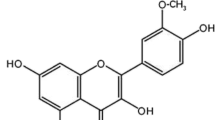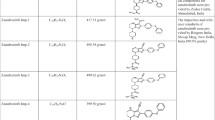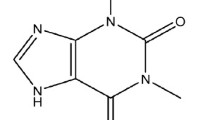Summary
Besides its many pharmacodynamic actions, the pyridoindole stobadine was found to exert antioxidant activity and thus possesses the potential to protect various tissues against oxidative stress. This overview is focussed on both the evaluation of the chemical procedures used in the bioassay of stobadine and its metabolites and on the comparison of their quality in the light of applicability for preclinical and clinical pharmacokinetic experiments. All methods and applications were performed at the Institute of Experimental Pharmacology, SASc in Bratislava, Slovakia. In pharmacokinetic and toxicokinetic studies, [3H]-labeled stobadine dihydrochloride was administered intravenously or orally to rats in single and repeated doses. Liquid-liquid extraction was used for selective isolation of stobadine and its metabolites from biological matrix, followed by liquid scintillation quantification. A TLRC method was developed both to check the radiochemical purity of [3H]-stobadine and to quantify the labeled drug in rat plasma. A spectrofluorometric approach was used for determination of stobadine in dog serum and urine after its administration in the form of either the dihydrochloride or the dipalmitate. The method allowed us to perform a bioavailability study and a long-term toxicological study. The HPLC method with a limit of detection of 10 ng/ml of plasma proved suitable for calculating the compartmental pharmacokinetic parameters of both salt forms of stobadine administered to dog and man. This method was based on solid-phase extraction procedure by using Separcol SI C18 cartridges. In a GC method, the combination of capillary column separation and nitrogen-specific detection permitted the assay of serum stobadine concentrations as low as 5 ng/ml. The detection limit of the GC/MS method was 1 ng/ml of plasma or of phosphate buffer saline. This method was used for a bioequivalence study of two stobadine dipalmitate dosage forms and for a transdermal penetration study of stobadine acyl derivatives. All the developed assays proved to be appropriate for low-concentration determination of stobadine in a wide range of pharmacokinetic studies.
Similar content being viewed by others
References
Stolc S., Bauer V., Benes L., Tichy Z. (1983): Medicine with antiarrhythmic and antihypoxic activity and its method of preparation. Patents: CS 229067, SWED. 8204693-9, BELG. 894148, SWISS 651754, BRD P-3231088, SPAIN 553017, JAP. 1514040.
Horáková Ĺ., Stolc S. (1998): Review: antioxidant and pharmacodynamic effects of pyridoindole stobadine. Gen. Pharmacol., 30: 627–638.
Stefek M., Benes Ĺ., Jergelová M., Scasnár V., Turi-Nagy L., Kocis P. (1987): Biotransformation of stobadine, a γ-carboline antiarrhythmic and cardioprotective agent, in rat liver microsomes. Xenobiotica, 17: 1067–1073.
Scasnár V., Stefek M. (1987): Solvent extraction and radiometric determination of [3H]-stobadine in biological material. J. Radioanal. Nucl. Chem., 111: 117–122.
Kállay Z., Bittererová J., Brejcha A., Fáberová V., Bezek S., Trnovec T. (1990): Plasma concentration, tissue distribution and excretion of the prospective cardioprotective agent cis(−)-2,3,4,4a,5,9b-hexahydro-2,8-dimethyl-1H-pyrido-[4,3b-b] indole dihydrochloride in rats. Arzneimittelforschung, 40: 974–979.
Kállay Z., Soltés L., Trnovec T. (1991): Pharmacokinetics of stobadin and of the sum of its metabolites in rats during repeated administration. Biopharm Drug Dispos., 12: 201–205.
Ujházy E., Fáberová V., Zemánek M., Dubovicky M., Jansák J. (1993): Maternal-fetal distribution of stobadine in rabbits. Teratology, 48: 40.
Ujházy E., Fáberová V., Dubovický M., et al. (1995): Placental transfer of stobadine at different gestational stages in rabbits — approximation by pharmacokinetic model [in Slovak]. Cs. Fyziol., 44: 15–17.
Kristofová A., Ujházy E., Bezek S., Balónová T., Nosál’ R. (1991): Stobadine toxicity and transplacental movement. Arch. Toxicol., 14 (Suppl): 280–284.
Scasnár V., Bezek S., Trnovec T. (1989): Fluorimetric assay of stobadine in serum of dogs. J. Pharm. Biomed. Anal., 7: 1207–1212.
Marko V. (1985): Spectrofluorometric analysis in biological fluids of the dihydrochloride of (−)-cis-2,8-dimethyl-2,3,4,4a,5,9b-hexahydro-1-H-pyrido [4,3b]-indole (DH 1011), a prospective antiarrythmic. Pharmazie, 40: 192.
Bezek S., Scasnár V., Durisová M., Trnovec T., Kukan M. (1988): Stobadine bioavailability in dogs [in Slovak]. Cs. Fyziol., 37: 240.
Majerčík M., Babinská M., Ujházy E., Babulová A., Balónová T. (1984): Six-month toxicology study of the substance DP 1031 in beagle dogs [in Slovak]. Cs. Fyziol., 33: 171.
Soltés L., Kállay Z., Bezek S., Fedelesová V. (1991): A high-performance liquid chromatographic method for the determination of stobadin pharmacokinetics in serum. Biopharm. Drug Dispos., 12: 29–35.
Bittererová J., Soltés L., Kállay Z., Trnovec T. (1991): Thinlayer chromatographic determination of3H-labelled stobadin in rat plasma for pharmacokinetic purposes. Pharmazie, 45: 437–438.
Marko V. (1988): Determination of stobadine, a novel cardioprotective drug, using capillary gas chromatography with nitrogen-phosphorus detection after selective solid-phase extraction from serum. J. Chromatogr., 433: 269–275.
Bauerová K., Bezek S., Bohov P., Durišová M., Kukan M. (1995): Evaluation of relative bioavailability of two stobadine preparations in dogs. Ther. Drug Monit., 17: 423.
Koprda V., Mihalová D., Bohácik Ĺ (1998): The effect of Azone on penetration of pyridoindole acylderivatives across 5-day-rat skin. Proc. 6th International Conference: Perspectives in Percutaneous Penetration, Leiden, The Netherlands, September 22–26 1998 Vol. 6A, 29–31.
Marko V., Soltés L., Radová K. (1990): Polar interactions in solid-phase extraction of basic drugs by octadecylsilanized silica. J. Chromatogr. Sci., 18: 403–406.
Marko V., Soltés L., Novák I. (1990): Selective solid-phase extraction of basic drugs by C18-silica. Discussion of possible interactions. J. Pharm. Biomed. Anal., 8: 297–301
Author information
Authors and Affiliations
Rights and permissions
About this article
Cite this article
Bauerová, K. Overview of stobadine bioanalysis: evaluation and application in pharmacokinetics. Eur. J. Drug Metab. Pharmacokinet. 24, 237–242 (1999). https://doi.org/10.1007/BF03190026
Received:
Issue Date:
DOI: https://doi.org/10.1007/BF03190026




